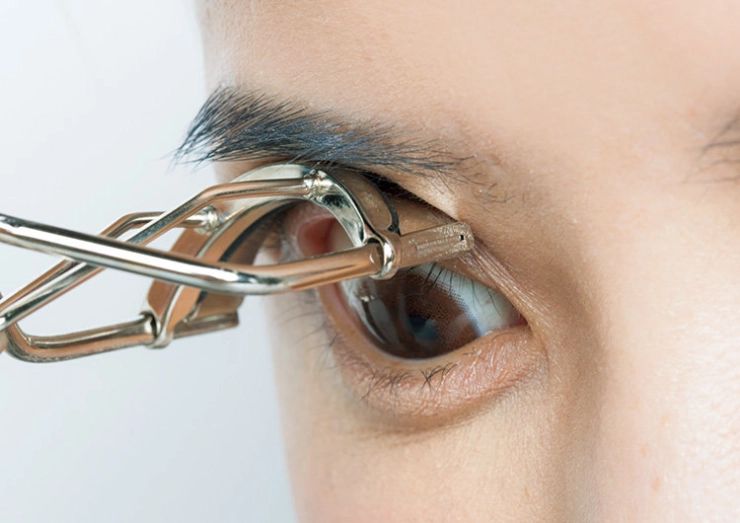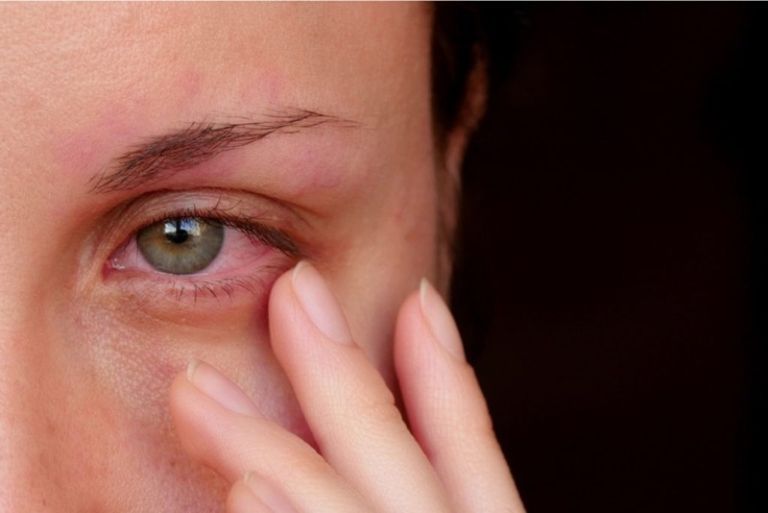Introduction
Makeup is a daily habit for many people, including those with high myopia. However, the eye area of people with severe nearsightedness is often more sensitive, more prone to dryness, irritation, and infection. Incorrect makeup practices can lead to blurry vision, discomfort, or more serious issues such as conjunctivitis, keratitis, or styes. This article summarizes the 5 most common mistakes people with high myopia make when applying makeup, along with safe solutions to help you stay beautiful while protecting your eyes.
1. Going to sleep without removing eye makeup

Carefully removing eye makeup helps reduce dry eye and eyelid inflammation
This is the most harmful yet most common mistake. Leftover mascara, eyeshadow, or eyeliner will mix with dust, oil, and bacteria overnight, creating a mixture that easily irritates the eyelids.
For people with severe myopia who wear glasses frequently, the skin around the eyes is already under pressure from the frame. When makeup is not properly removed, the eyes easily become red, itchy, dry, or watery. Residue left on the lashes can clog the meibomian glands — the leading cause of dry eye and eyelid inflammation.
How to fix it:
- Use makeup removers specifically for the eyes, preferably oil-based or gentle micellar formulas.
- If you’re too tired to wash your face, use a damp makeup-removing wipe before bed.
- Even when you don’t wear makeup, people with myopia should clean the eyelids daily to remove dust and excess oil.
2. Sharing eye makeup products
Sharing eyeliners, mascaras, or eyeshadow brushes with others may seem harmless but can actually cause eye infections after just one shared use.
Bacteria and fungi can hide in eye makeup products longer than you think. For those with severe myopia who already experience eye fatigue and dryness more easily, the risk of infection is higher if bacteria from makeup enter the eye. This can result in conjunctivitis, keratitis, red eyes, pain, or swollen eyelids.
How to fix it:
- Never share mascara or eyeliner.
- Clean your eyeshadow brushes 1–2 times per week.
- If you have had an eye infection, discard all makeup used during that time to prevent reinfection.
3. Using old or expired makeup

Avoid using old or expired makeup on the sensitive eye area
People with severe myopia often apply makeup very close to the mirror, making it easier for the eyeliner tip or mascara wand to touch the eye during application. This increases the risk of introducing bacteria from old mascara into the eye.
Makeup that has been opened for more than six months starts to change texture, lose effectiveness, and become more prone to bacterial contamination. When these products contact the surface of the eye or eyelashes, they can cause irritation, a gritty feeling, or even corneal damage.
How to fix it:
- Replace mascara and eyeliner every 3–6 months.
- If you have had an eye infection, dispose of all eye makeup used during that period.
- Choose products with clear expiration dates and store them in a dry, cool place.
4. Not reading product ingredients before use
Some people with severe myopia naturally have sensitive eyes that are prone to dryness and allergies. If you choose makeup without checking the ingredients, you may accidentally apply substances that cause strong irritation.
Ingredients such as talc, BHA (butylated hydroxyanisole), and phthalates are commonly used to stabilize formulas but can irritate the skin and eyelids when used long term or frequently.
How to fix it:
- Choose products labeled “ophthalmologist-tested”, “eye-safe”, or “allergy-tested”.
- Avoid products with strong fragrances, harsh alcohols, or irritating preservatives.
- If your eyes become red or itchy after using a product, stop immediately and switch to a gentler option.
5. Overusing false eyelashes and eyelash glue

Eyelash extensions can make cleaning the lash line more difficult
False eyelashes make the eyes look deeper and more defined — especially for people with severe myopia who want their eyes to look larger behind the glasses. However, eyelash glue is one of the leading causes of eyelid inflammation, rashes, or lash shedding.
If you use false eyelashes frequently, glue residue can accumulate along the lash line, causing blockage and making cleaning more difficult. Eyelash extensions can make cleaning the lashes and eyelid area harder, leading to infection. This is especially risky for people with severe myopia, who are already prone to dry eyes and eyelid inflammation from wearing glasses or contact lenses.
How to fix it:
- Only use false eyelashes on necessary occasions.
- Choose eyelash glue that does not contain formaldehyde.
- After removing false lashes, clean the lash line thoroughly with a specialized cleanser.
Notes
In addition to the 5 common mistakes above, people with severe myopia should keep in mind:
Wash your hands before applying makeup
Bacteria on your hands can transfer directly to the eyelids when you blend eyeshadow with your fingers or adjust your mascara. Washing your hands with soap for 20–30 seconds before makeup is a small but essential step.
Rinse your eyes properly if makeup gets in
Pigments from eyeshadow, mascara, or eyeliner can enter the eye and cause stinging or redness.
Here’s the correct way to handle it:
- Rinse with clean water or an eye rinse solution until all residue is removed.
- Use lubricating eye drops to soothe the irritation.
- If you wear contact lenses, remove them immediately and only put them back on when the irritation is gone.
Makeup is not the “enemy” of people with severe myopia. In fact, by choosing safe products and avoiding the 5 common mistakes above, you can wear makeup every day while keeping your eyes clear, bright, and healthy. Eyes with high myopia require more care, but just a few small changes in your makeup routine can help reduce irritation, lower the risk of infection, and protect your vision long-term.
If you often experience redness, dryness, or discomfort after applying makeup, visit an eye care clinic for early examination — beautiful eyes matter, but healthy eyes matter even more.

 vi
vi 17-Nov-2025
17-Nov-2025












 0916.741.763
0916.741.763 Appointment
Appointment